An Annotated Bibliography: Health Promotion Strategies Nipah Virus
VerifiedAdded on 2023/06/08
|18
|5453
|174
Annotated Bibliography
AI Summary
This annotated bibliography examines health promotion strategies in response to the Nipah virus (NiV) outbreak in Kerala, India, focusing on interventions to prevent transmission from fruit bats to humans. It analyzes five research papers, each addressing different aspects of Nipah virus prevention. The papers explore interventions such as using bamboo skirts to protect date palm sap from bat contamination, disseminating health messages through public service announcements, and evaluating policy options like integrated education and surveillance programs. The bibliography also highlights the importance of culturally sensitive communication strategies to promote behavior change and prevent the spread of the virus. It emphasizes the need for effective, multi-faceted approaches to address the complex challenges posed by Nipah virus outbreaks.
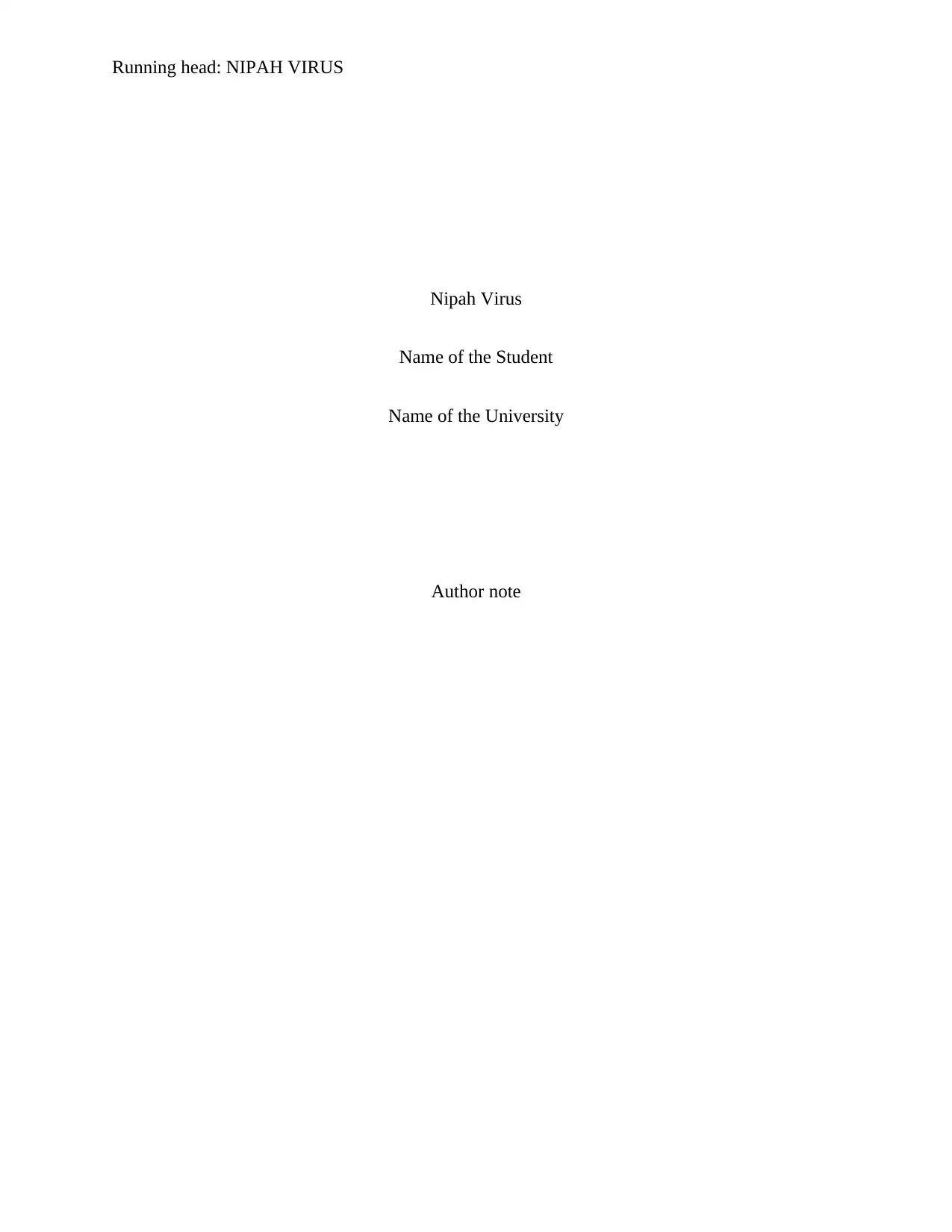
Running head: NIPAH VIRUS
Nipah Virus
Name of the Student
Name of the University
Author note
Nipah Virus
Name of the Student
Name of the University
Author note
Paraphrase This Document
Need a fresh take? Get an instant paraphrase of this document with our AI Paraphraser
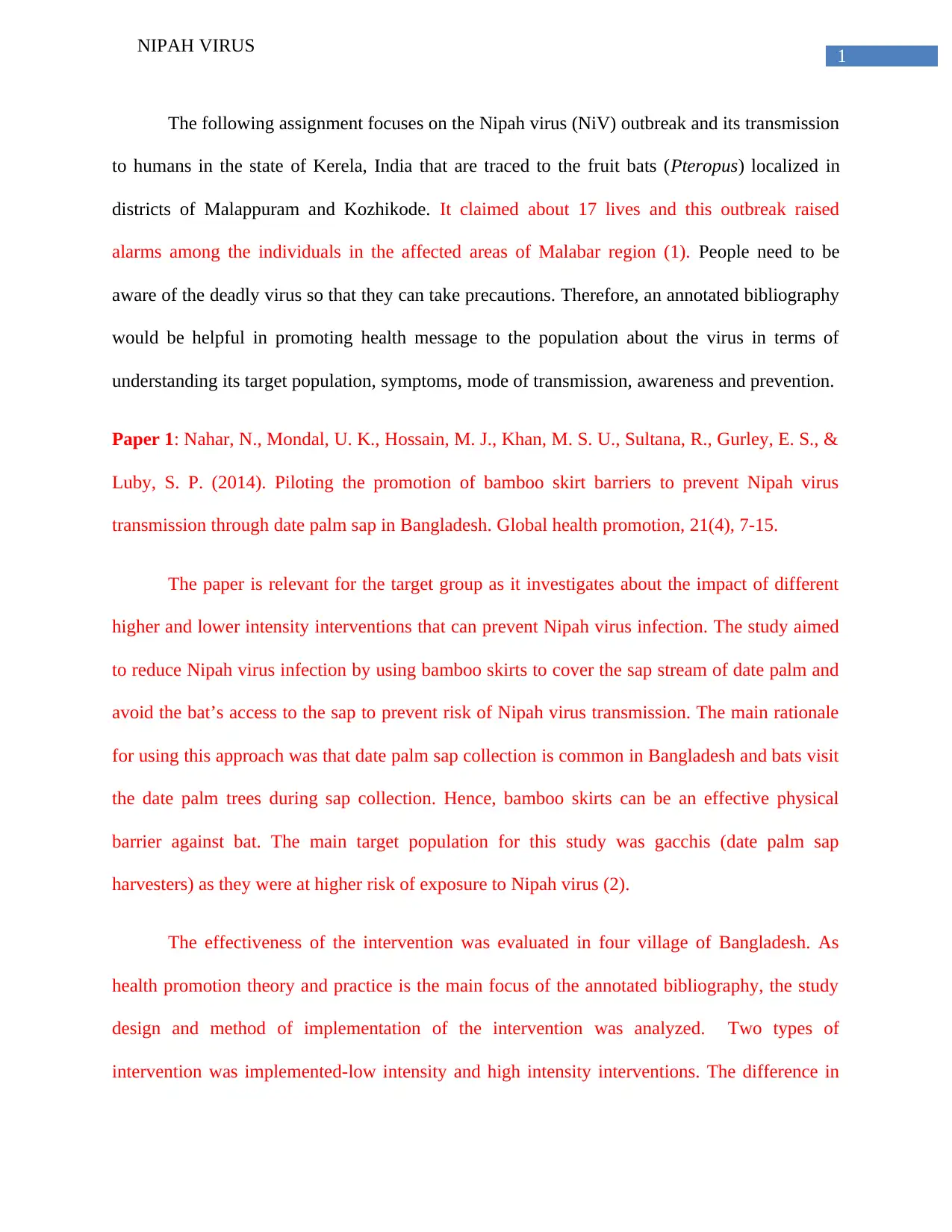
1
NIPAH VIRUS
The following assignment focuses on the Nipah virus (NiV) outbreak and its transmission
to humans in the state of Kerela, India that are traced to the fruit bats (Pteropus) localized in
districts of Malappuram and Kozhikode. It claimed about 17 lives and this outbreak raised
alarms among the individuals in the affected areas of Malabar region (1). People need to be
aware of the deadly virus so that they can take precautions. Therefore, an annotated bibliography
would be helpful in promoting health message to the population about the virus in terms of
understanding its target population, symptoms, mode of transmission, awareness and prevention.
Paper 1: Nahar, N., Mondal, U. K., Hossain, M. J., Khan, M. S. U., Sultana, R., Gurley, E. S., &
Luby, S. P. (2014). Piloting the promotion of bamboo skirt barriers to prevent Nipah virus
transmission through date palm sap in Bangladesh. Global health promotion, 21(4), 7-15.
The paper is relevant for the target group as it investigates about the impact of different
higher and lower intensity interventions that can prevent Nipah virus infection. The study aimed
to reduce Nipah virus infection by using bamboo skirts to cover the sap stream of date palm and
avoid the bat’s access to the sap to prevent risk of Nipah virus transmission. The main rationale
for using this approach was that date palm sap collection is common in Bangladesh and bats visit
the date palm trees during sap collection. Hence, bamboo skirts can be an effective physical
barrier against bat. The main target population for this study was gacchis (date palm sap
harvesters) as they were at higher risk of exposure to Nipah virus (2).
The effectiveness of the intervention was evaluated in four village of Bangladesh. As
health promotion theory and practice is the main focus of the annotated bibliography, the study
design and method of implementation of the intervention was analyzed. Two types of
intervention was implemented-low intensity and high intensity interventions. The difference in
NIPAH VIRUS
The following assignment focuses on the Nipah virus (NiV) outbreak and its transmission
to humans in the state of Kerela, India that are traced to the fruit bats (Pteropus) localized in
districts of Malappuram and Kozhikode. It claimed about 17 lives and this outbreak raised
alarms among the individuals in the affected areas of Malabar region (1). People need to be
aware of the deadly virus so that they can take precautions. Therefore, an annotated bibliography
would be helpful in promoting health message to the population about the virus in terms of
understanding its target population, symptoms, mode of transmission, awareness and prevention.
Paper 1: Nahar, N., Mondal, U. K., Hossain, M. J., Khan, M. S. U., Sultana, R., Gurley, E. S., &
Luby, S. P. (2014). Piloting the promotion of bamboo skirt barriers to prevent Nipah virus
transmission through date palm sap in Bangladesh. Global health promotion, 21(4), 7-15.
The paper is relevant for the target group as it investigates about the impact of different
higher and lower intensity interventions that can prevent Nipah virus infection. The study aimed
to reduce Nipah virus infection by using bamboo skirts to cover the sap stream of date palm and
avoid the bat’s access to the sap to prevent risk of Nipah virus transmission. The main rationale
for using this approach was that date palm sap collection is common in Bangladesh and bats visit
the date palm trees during sap collection. Hence, bamboo skirts can be an effective physical
barrier against bat. The main target population for this study was gacchis (date palm sap
harvesters) as they were at higher risk of exposure to Nipah virus (2).
The effectiveness of the intervention was evaluated in four village of Bangladesh. As
health promotion theory and practice is the main focus of the annotated bibliography, the study
design and method of implementation of the intervention was analyzed. Two types of
intervention was implemented-low intensity and high intensity interventions. The difference in
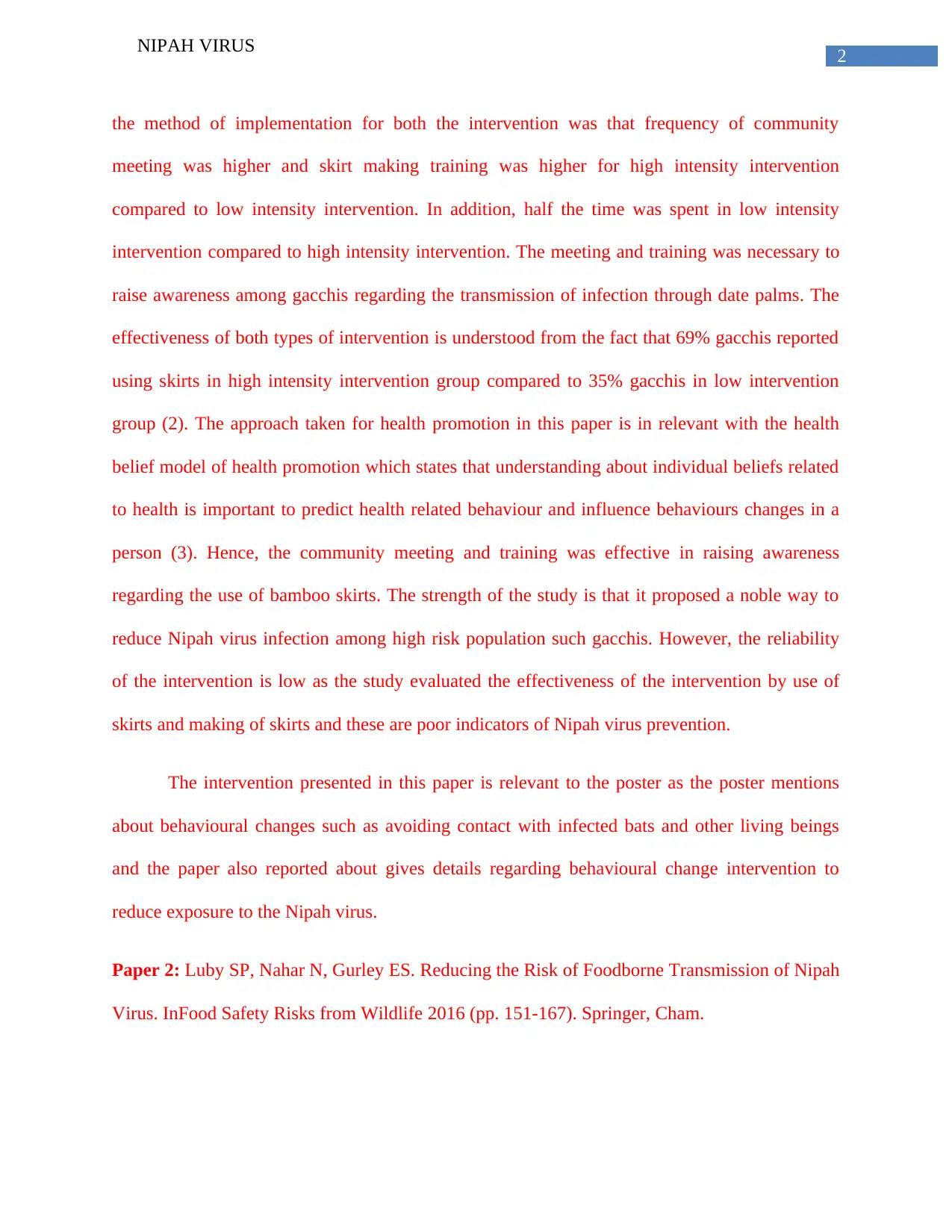
2
NIPAH VIRUS
the method of implementation for both the intervention was that frequency of community
meeting was higher and skirt making training was higher for high intensity intervention
compared to low intensity intervention. In addition, half the time was spent in low intensity
intervention compared to high intensity intervention. The meeting and training was necessary to
raise awareness among gacchis regarding the transmission of infection through date palms. The
effectiveness of both types of intervention is understood from the fact that 69% gacchis reported
using skirts in high intensity intervention group compared to 35% gacchis in low intervention
group (2). The approach taken for health promotion in this paper is in relevant with the health
belief model of health promotion which states that understanding about individual beliefs related
to health is important to predict health related behaviour and influence behaviours changes in a
person (3). Hence, the community meeting and training was effective in raising awareness
regarding the use of bamboo skirts. The strength of the study is that it proposed a noble way to
reduce Nipah virus infection among high risk population such gacchis. However, the reliability
of the intervention is low as the study evaluated the effectiveness of the intervention by use of
skirts and making of skirts and these are poor indicators of Nipah virus prevention.
The intervention presented in this paper is relevant to the poster as the poster mentions
about behavioural changes such as avoiding contact with infected bats and other living beings
and the paper also reported about gives details regarding behavioural change intervention to
reduce exposure to the Nipah virus.
Paper 2: Luby SP, Nahar N, Gurley ES. Reducing the Risk of Foodborne Transmission of Nipah
Virus. InFood Safety Risks from Wildlife 2016 (pp. 151-167). Springer, Cham.
NIPAH VIRUS
the method of implementation for both the intervention was that frequency of community
meeting was higher and skirt making training was higher for high intensity intervention
compared to low intensity intervention. In addition, half the time was spent in low intensity
intervention compared to high intensity intervention. The meeting and training was necessary to
raise awareness among gacchis regarding the transmission of infection through date palms. The
effectiveness of both types of intervention is understood from the fact that 69% gacchis reported
using skirts in high intensity intervention group compared to 35% gacchis in low intervention
group (2). The approach taken for health promotion in this paper is in relevant with the health
belief model of health promotion which states that understanding about individual beliefs related
to health is important to predict health related behaviour and influence behaviours changes in a
person (3). Hence, the community meeting and training was effective in raising awareness
regarding the use of bamboo skirts. The strength of the study is that it proposed a noble way to
reduce Nipah virus infection among high risk population such gacchis. However, the reliability
of the intervention is low as the study evaluated the effectiveness of the intervention by use of
skirts and making of skirts and these are poor indicators of Nipah virus prevention.
The intervention presented in this paper is relevant to the poster as the poster mentions
about behavioural changes such as avoiding contact with infected bats and other living beings
and the paper also reported about gives details regarding behavioural change intervention to
reduce exposure to the Nipah virus.
Paper 2: Luby SP, Nahar N, Gurley ES. Reducing the Risk of Foodborne Transmission of Nipah
Virus. InFood Safety Risks from Wildlife 2016 (pp. 151-167). Springer, Cham.
⊘ This is a preview!⊘
Do you want full access?
Subscribe today to unlock all pages.

Trusted by 1+ million students worldwide
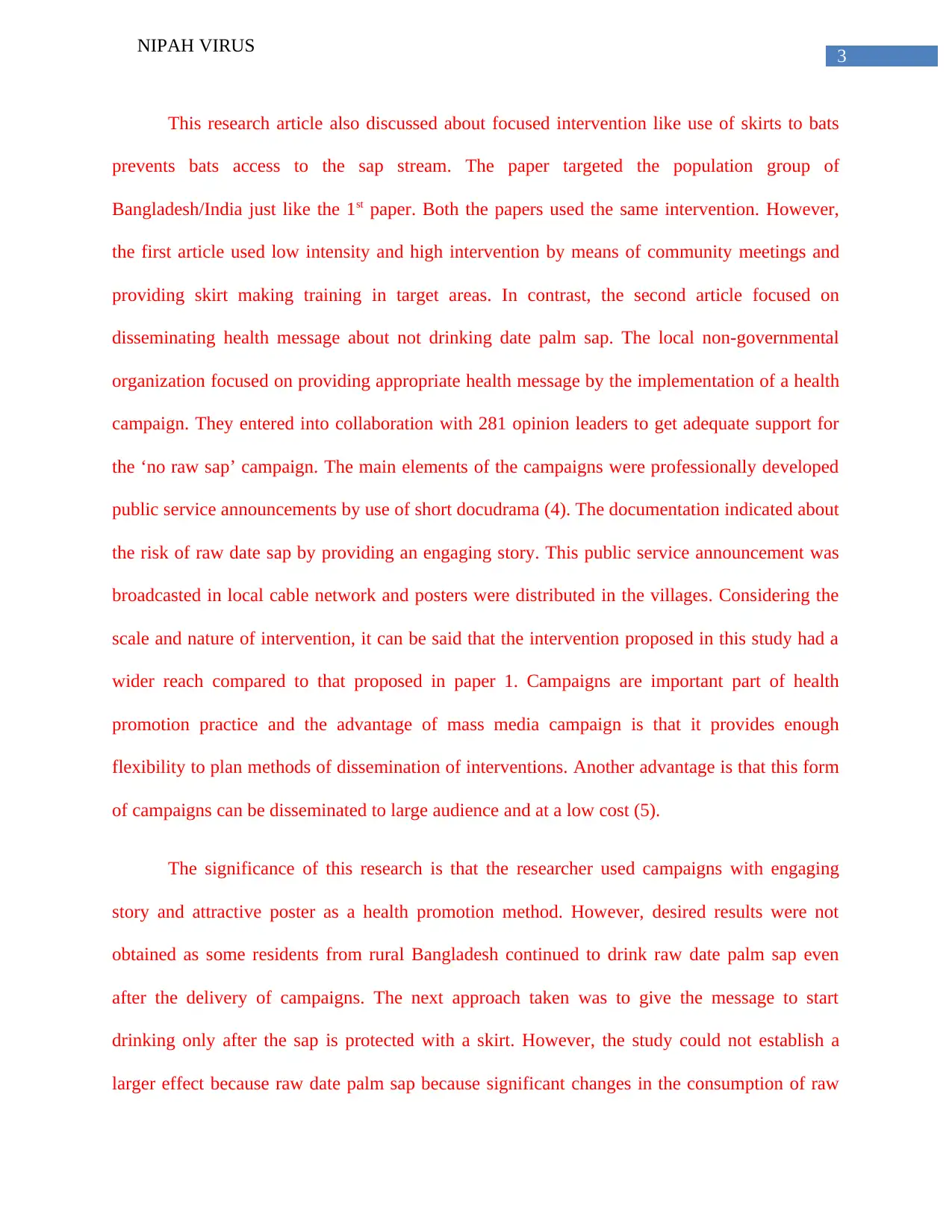
3
NIPAH VIRUS
This research article also discussed about focused intervention like use of skirts to bats
prevents bats access to the sap stream. The paper targeted the population group of
Bangladesh/India just like the 1st paper. Both the papers used the same intervention. However,
the first article used low intensity and high intervention by means of community meetings and
providing skirt making training in target areas. In contrast, the second article focused on
disseminating health message about not drinking date palm sap. The local non-governmental
organization focused on providing appropriate health message by the implementation of a health
campaign. They entered into collaboration with 281 opinion leaders to get adequate support for
the ‘no raw sap’ campaign. The main elements of the campaigns were professionally developed
public service announcements by use of short docudrama (4). The documentation indicated about
the risk of raw date sap by providing an engaging story. This public service announcement was
broadcasted in local cable network and posters were distributed in the villages. Considering the
scale and nature of intervention, it can be said that the intervention proposed in this study had a
wider reach compared to that proposed in paper 1. Campaigns are important part of health
promotion practice and the advantage of mass media campaign is that it provides enough
flexibility to plan methods of dissemination of interventions. Another advantage is that this form
of campaigns can be disseminated to large audience and at a low cost (5).
The significance of this research is that the researcher used campaigns with engaging
story and attractive poster as a health promotion method. However, desired results were not
obtained as some residents from rural Bangladesh continued to drink raw date palm sap even
after the delivery of campaigns. The next approach taken was to give the message to start
drinking only after the sap is protected with a skirt. However, the study could not establish a
larger effect because raw date palm sap because significant changes in the consumption of raw
NIPAH VIRUS
This research article also discussed about focused intervention like use of skirts to bats
prevents bats access to the sap stream. The paper targeted the population group of
Bangladesh/India just like the 1st paper. Both the papers used the same intervention. However,
the first article used low intensity and high intervention by means of community meetings and
providing skirt making training in target areas. In contrast, the second article focused on
disseminating health message about not drinking date palm sap. The local non-governmental
organization focused on providing appropriate health message by the implementation of a health
campaign. They entered into collaboration with 281 opinion leaders to get adequate support for
the ‘no raw sap’ campaign. The main elements of the campaigns were professionally developed
public service announcements by use of short docudrama (4). The documentation indicated about
the risk of raw date sap by providing an engaging story. This public service announcement was
broadcasted in local cable network and posters were distributed in the villages. Considering the
scale and nature of intervention, it can be said that the intervention proposed in this study had a
wider reach compared to that proposed in paper 1. Campaigns are important part of health
promotion practice and the advantage of mass media campaign is that it provides enough
flexibility to plan methods of dissemination of interventions. Another advantage is that this form
of campaigns can be disseminated to large audience and at a low cost (5).
The significance of this research is that the researcher used campaigns with engaging
story and attractive poster as a health promotion method. However, desired results were not
obtained as some residents from rural Bangladesh continued to drink raw date palm sap even
after the delivery of campaigns. The next approach taken was to give the message to start
drinking only after the sap is protected with a skirt. However, the study could not establish a
larger effect because raw date palm sap because significant changes in the consumption of raw
Paraphrase This Document
Need a fresh take? Get an instant paraphrase of this document with our AI Paraphraser
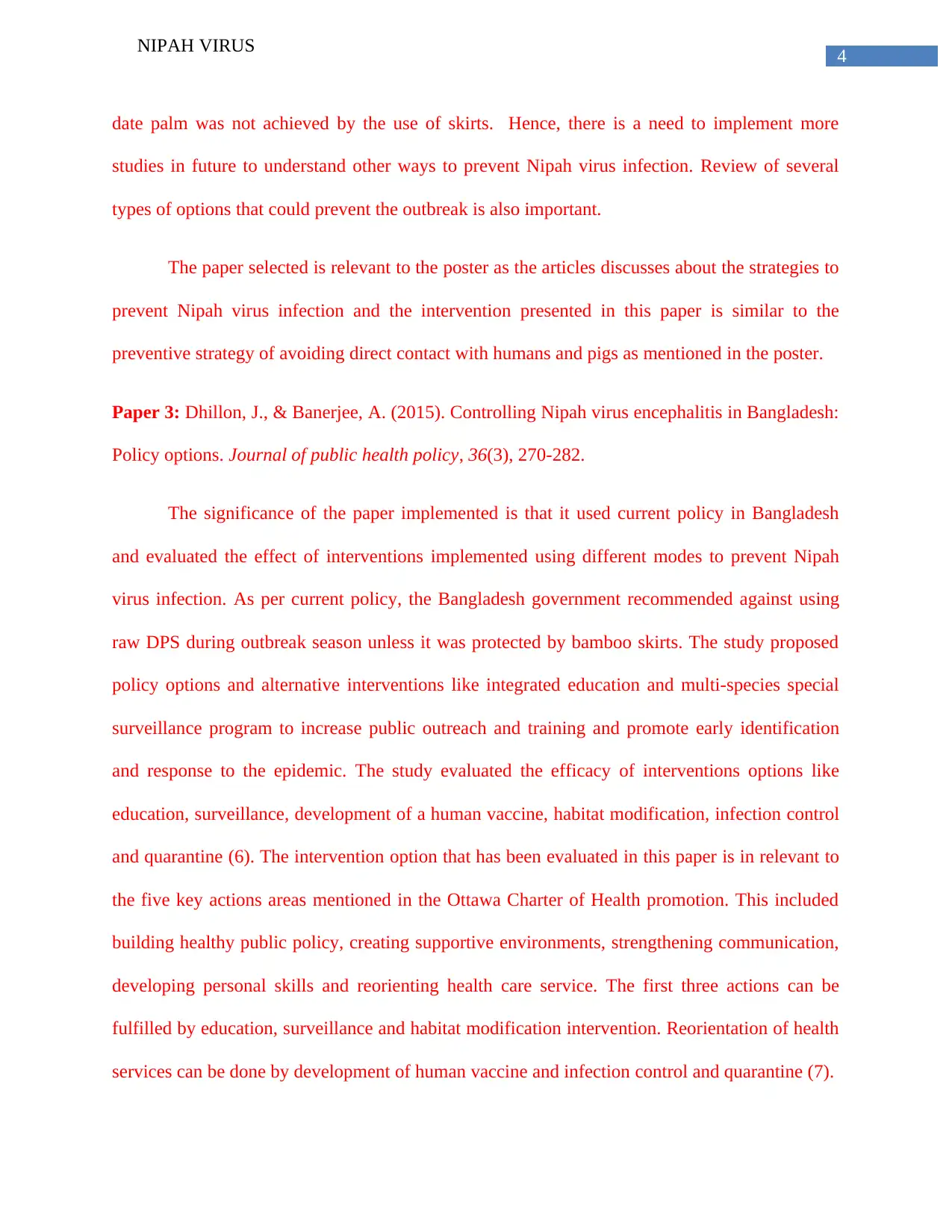
4
NIPAH VIRUS
date palm was not achieved by the use of skirts. Hence, there is a need to implement more
studies in future to understand other ways to prevent Nipah virus infection. Review of several
types of options that could prevent the outbreak is also important.
The paper selected is relevant to the poster as the articles discusses about the strategies to
prevent Nipah virus infection and the intervention presented in this paper is similar to the
preventive strategy of avoiding direct contact with humans and pigs as mentioned in the poster.
Paper 3: Dhillon, J., & Banerjee, A. (2015). Controlling Nipah virus encephalitis in Bangladesh:
Policy options. Journal of public health policy, 36(3), 270-282.
The significance of the paper implemented is that it used current policy in Bangladesh
and evaluated the effect of interventions implemented using different modes to prevent Nipah
virus infection. As per current policy, the Bangladesh government recommended against using
raw DPS during outbreak season unless it was protected by bamboo skirts. The study proposed
policy options and alternative interventions like integrated education and multi-species special
surveillance program to increase public outreach and training and promote early identification
and response to the epidemic. The study evaluated the efficacy of interventions options like
education, surveillance, development of a human vaccine, habitat modification, infection control
and quarantine (6). The intervention option that has been evaluated in this paper is in relevant to
the five key actions areas mentioned in the Ottawa Charter of Health promotion. This included
building healthy public policy, creating supportive environments, strengthening communication,
developing personal skills and reorienting health care service. The first three actions can be
fulfilled by education, surveillance and habitat modification intervention. Reorientation of health
services can be done by development of human vaccine and infection control and quarantine (7).
NIPAH VIRUS
date palm was not achieved by the use of skirts. Hence, there is a need to implement more
studies in future to understand other ways to prevent Nipah virus infection. Review of several
types of options that could prevent the outbreak is also important.
The paper selected is relevant to the poster as the articles discusses about the strategies to
prevent Nipah virus infection and the intervention presented in this paper is similar to the
preventive strategy of avoiding direct contact with humans and pigs as mentioned in the poster.
Paper 3: Dhillon, J., & Banerjee, A. (2015). Controlling Nipah virus encephalitis in Bangladesh:
Policy options. Journal of public health policy, 36(3), 270-282.
The significance of the paper implemented is that it used current policy in Bangladesh
and evaluated the effect of interventions implemented using different modes to prevent Nipah
virus infection. As per current policy, the Bangladesh government recommended against using
raw DPS during outbreak season unless it was protected by bamboo skirts. The study proposed
policy options and alternative interventions like integrated education and multi-species special
surveillance program to increase public outreach and training and promote early identification
and response to the epidemic. The study evaluated the efficacy of interventions options like
education, surveillance, development of a human vaccine, habitat modification, infection control
and quarantine (6). The intervention option that has been evaluated in this paper is in relevant to
the five key actions areas mentioned in the Ottawa Charter of Health promotion. This included
building healthy public policy, creating supportive environments, strengthening communication,
developing personal skills and reorienting health care service. The first three actions can be
fulfilled by education, surveillance and habitat modification intervention. Reorientation of health
services can be done by development of human vaccine and infection control and quarantine (7).
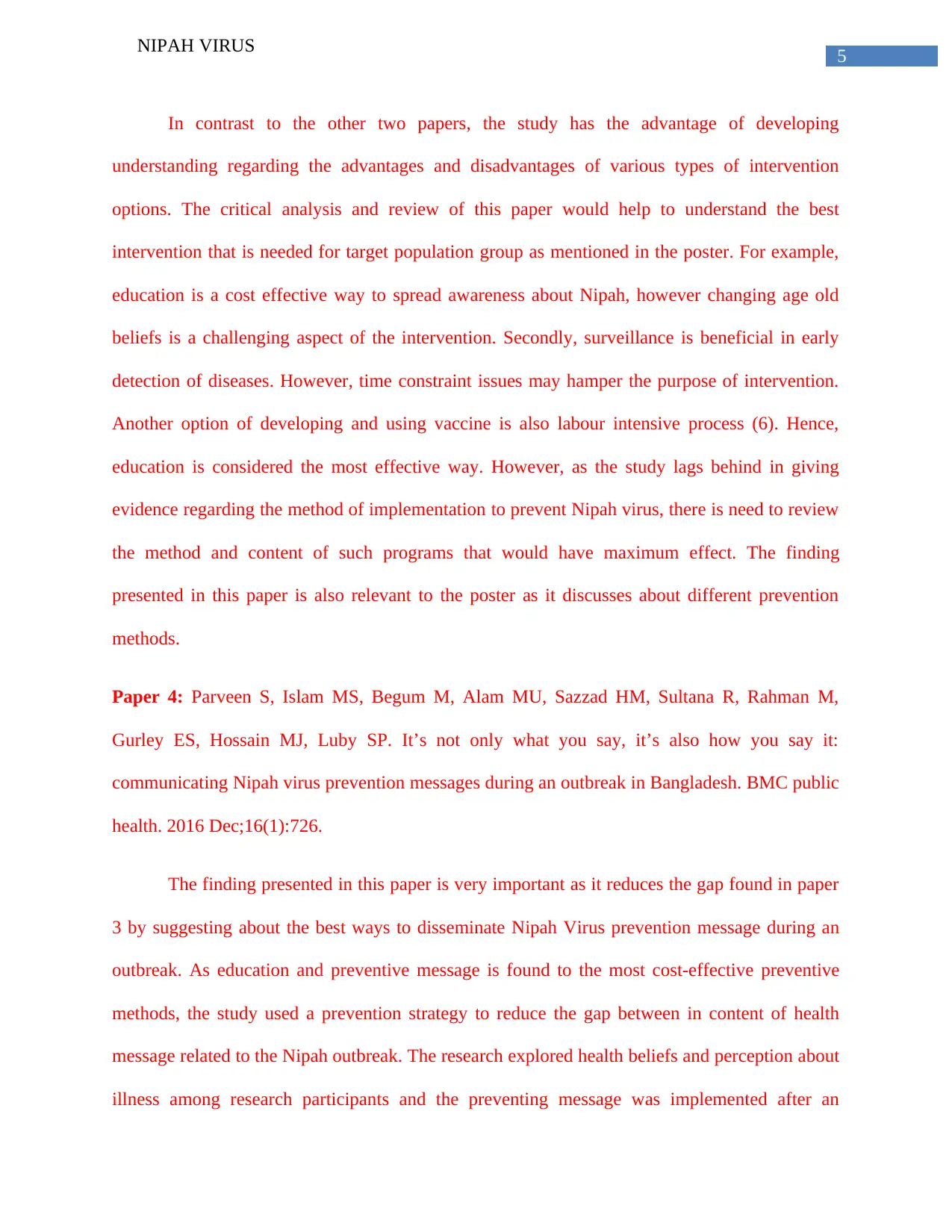
5
NIPAH VIRUS
In contrast to the other two papers, the study has the advantage of developing
understanding regarding the advantages and disadvantages of various types of intervention
options. The critical analysis and review of this paper would help to understand the best
intervention that is needed for target population group as mentioned in the poster. For example,
education is a cost effective way to spread awareness about Nipah, however changing age old
beliefs is a challenging aspect of the intervention. Secondly, surveillance is beneficial in early
detection of diseases. However, time constraint issues may hamper the purpose of intervention.
Another option of developing and using vaccine is also labour intensive process (6). Hence,
education is considered the most effective way. However, as the study lags behind in giving
evidence regarding the method of implementation to prevent Nipah virus, there is need to review
the method and content of such programs that would have maximum effect. The finding
presented in this paper is also relevant to the poster as it discusses about different prevention
methods.
Paper 4: Parveen S, Islam MS, Begum M, Alam MU, Sazzad HM, Sultana R, Rahman M,
Gurley ES, Hossain MJ, Luby SP. It’s not only what you say, it’s also how you say it:
communicating Nipah virus prevention messages during an outbreak in Bangladesh. BMC public
health. 2016 Dec;16(1):726.
The finding presented in this paper is very important as it reduces the gap found in paper
3 by suggesting about the best ways to disseminate Nipah Virus prevention message during an
outbreak. As education and preventive message is found to the most cost-effective preventive
methods, the study used a prevention strategy to reduce the gap between in content of health
message related to the Nipah outbreak. The research explored health beliefs and perception about
illness among research participants and the preventing message was implemented after an
NIPAH VIRUS
In contrast to the other two papers, the study has the advantage of developing
understanding regarding the advantages and disadvantages of various types of intervention
options. The critical analysis and review of this paper would help to understand the best
intervention that is needed for target population group as mentioned in the poster. For example,
education is a cost effective way to spread awareness about Nipah, however changing age old
beliefs is a challenging aspect of the intervention. Secondly, surveillance is beneficial in early
detection of diseases. However, time constraint issues may hamper the purpose of intervention.
Another option of developing and using vaccine is also labour intensive process (6). Hence,
education is considered the most effective way. However, as the study lags behind in giving
evidence regarding the method of implementation to prevent Nipah virus, there is need to review
the method and content of such programs that would have maximum effect. The finding
presented in this paper is also relevant to the poster as it discusses about different prevention
methods.
Paper 4: Parveen S, Islam MS, Begum M, Alam MU, Sazzad HM, Sultana R, Rahman M,
Gurley ES, Hossain MJ, Luby SP. It’s not only what you say, it’s also how you say it:
communicating Nipah virus prevention messages during an outbreak in Bangladesh. BMC public
health. 2016 Dec;16(1):726.
The finding presented in this paper is very important as it reduces the gap found in paper
3 by suggesting about the best ways to disseminate Nipah Virus prevention message during an
outbreak. As education and preventive message is found to the most cost-effective preventive
methods, the study used a prevention strategy to reduce the gap between in content of health
message related to the Nipah outbreak. The research explored health beliefs and perception about
illness among research participants and the preventing message was implemented after an
⊘ This is a preview!⊘
Do you want full access?
Subscribe today to unlock all pages.

Trusted by 1+ million students worldwide
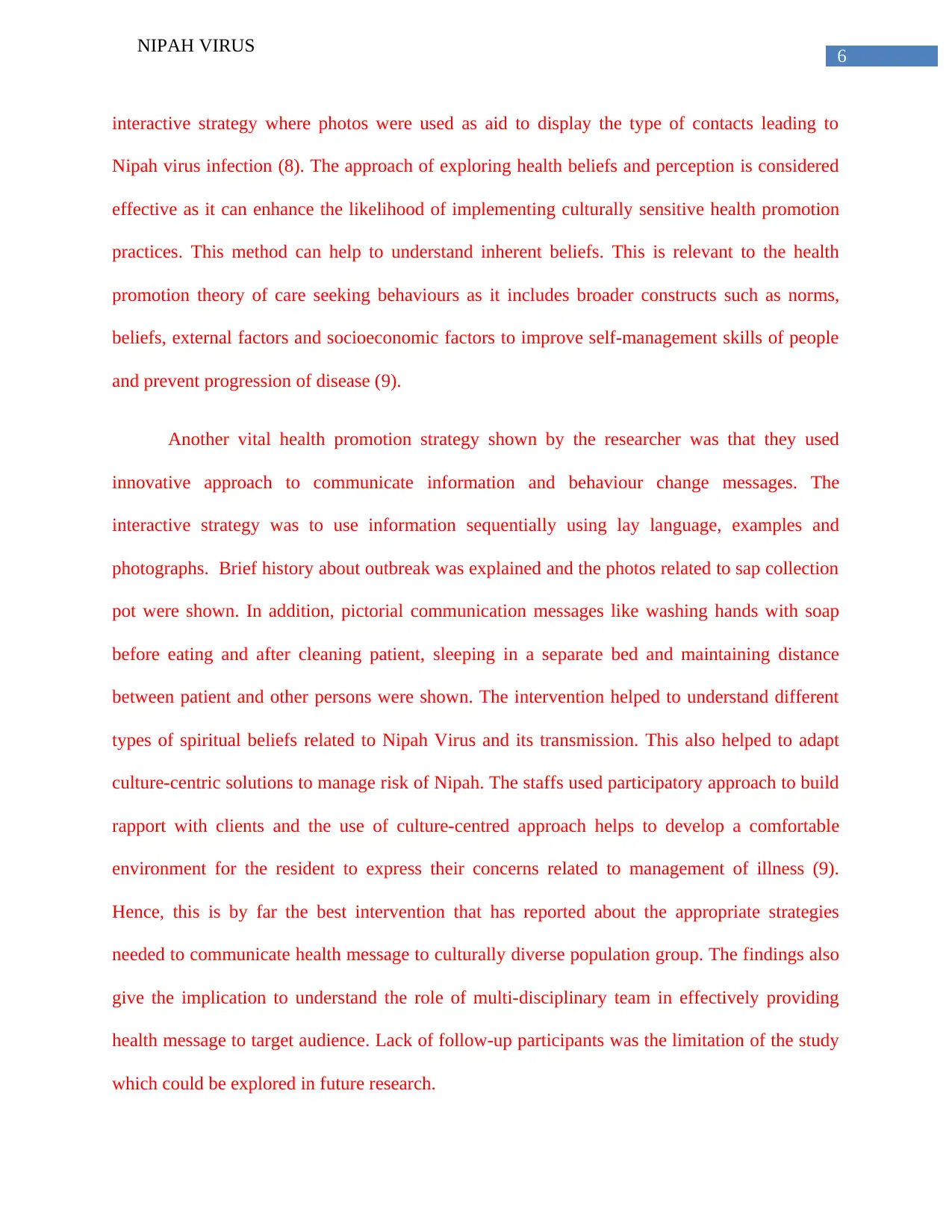
6
NIPAH VIRUS
interactive strategy where photos were used as aid to display the type of contacts leading to
Nipah virus infection (8). The approach of exploring health beliefs and perception is considered
effective as it can enhance the likelihood of implementing culturally sensitive health promotion
practices. This method can help to understand inherent beliefs. This is relevant to the health
promotion theory of care seeking behaviours as it includes broader constructs such as norms,
beliefs, external factors and socioeconomic factors to improve self-management skills of people
and prevent progression of disease (9).
Another vital health promotion strategy shown by the researcher was that they used
innovative approach to communicate information and behaviour change messages. The
interactive strategy was to use information sequentially using lay language, examples and
photographs. Brief history about outbreak was explained and the photos related to sap collection
pot were shown. In addition, pictorial communication messages like washing hands with soap
before eating and after cleaning patient, sleeping in a separate bed and maintaining distance
between patient and other persons were shown. The intervention helped to understand different
types of spiritual beliefs related to Nipah Virus and its transmission. This also helped to adapt
culture-centric solutions to manage risk of Nipah. The staffs used participatory approach to build
rapport with clients and the use of culture-centred approach helps to develop a comfortable
environment for the resident to express their concerns related to management of illness (9).
Hence, this is by far the best intervention that has reported about the appropriate strategies
needed to communicate health message to culturally diverse population group. The findings also
give the implication to understand the role of multi-disciplinary team in effectively providing
health message to target audience. Lack of follow-up participants was the limitation of the study
which could be explored in future research.
NIPAH VIRUS
interactive strategy where photos were used as aid to display the type of contacts leading to
Nipah virus infection (8). The approach of exploring health beliefs and perception is considered
effective as it can enhance the likelihood of implementing culturally sensitive health promotion
practices. This method can help to understand inherent beliefs. This is relevant to the health
promotion theory of care seeking behaviours as it includes broader constructs such as norms,
beliefs, external factors and socioeconomic factors to improve self-management skills of people
and prevent progression of disease (9).
Another vital health promotion strategy shown by the researcher was that they used
innovative approach to communicate information and behaviour change messages. The
interactive strategy was to use information sequentially using lay language, examples and
photographs. Brief history about outbreak was explained and the photos related to sap collection
pot were shown. In addition, pictorial communication messages like washing hands with soap
before eating and after cleaning patient, sleeping in a separate bed and maintaining distance
between patient and other persons were shown. The intervention helped to understand different
types of spiritual beliefs related to Nipah Virus and its transmission. This also helped to adapt
culture-centric solutions to manage risk of Nipah. The staffs used participatory approach to build
rapport with clients and the use of culture-centred approach helps to develop a comfortable
environment for the resident to express their concerns related to management of illness (9).
Hence, this is by far the best intervention that has reported about the appropriate strategies
needed to communicate health message to culturally diverse population group. The findings also
give the implication to understand the role of multi-disciplinary team in effectively providing
health message to target audience. Lack of follow-up participants was the limitation of the study
which could be explored in future research.
Paraphrase This Document
Need a fresh take? Get an instant paraphrase of this document with our AI Paraphraser
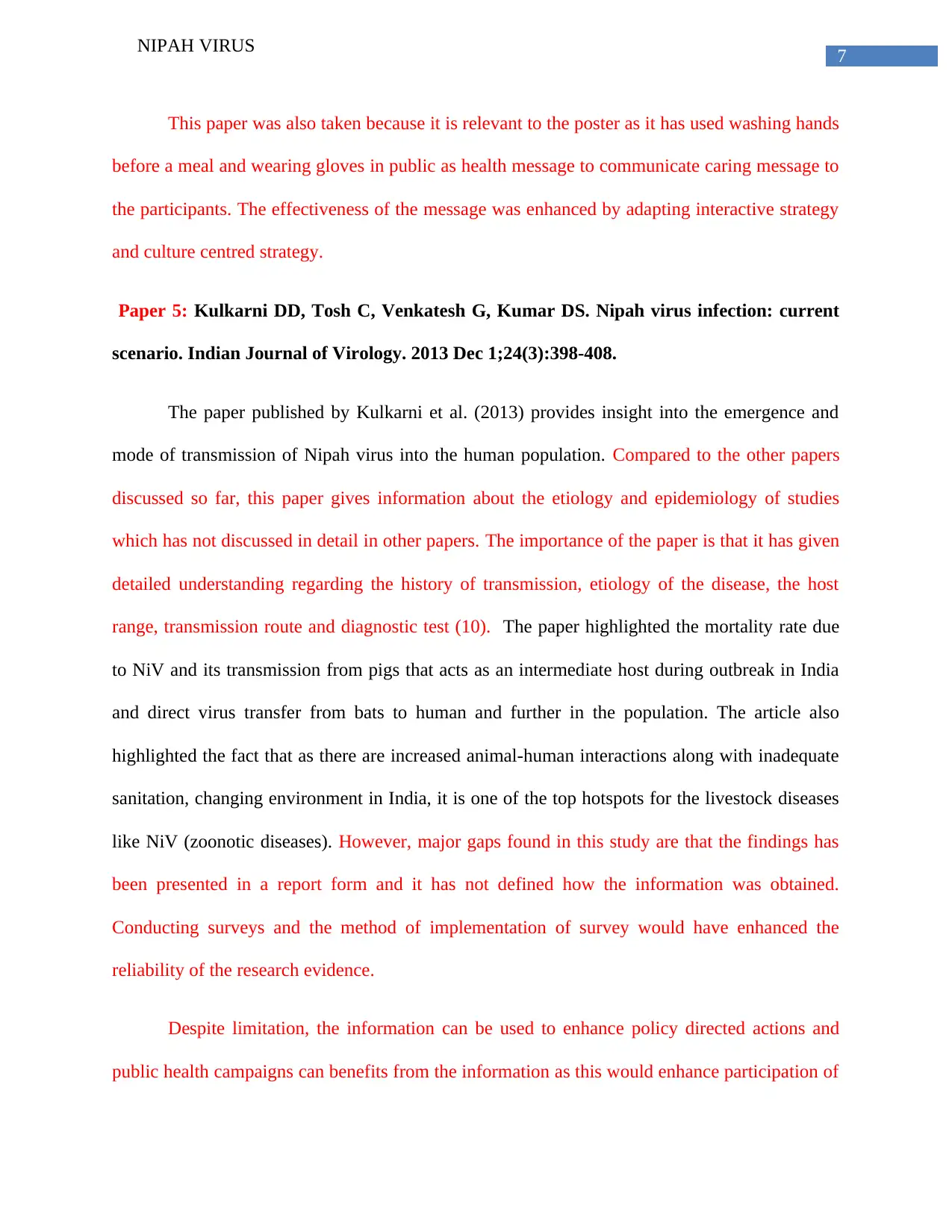
7
NIPAH VIRUS
This paper was also taken because it is relevant to the poster as it has used washing hands
before a meal and wearing gloves in public as health message to communicate caring message to
the participants. The effectiveness of the message was enhanced by adapting interactive strategy
and culture centred strategy.
Paper 5: Kulkarni DD, Tosh C, Venkatesh G, Kumar DS. Nipah virus infection: current
scenario. Indian Journal of Virology. 2013 Dec 1;24(3):398-408.
The paper published by Kulkarni et al. (2013) provides insight into the emergence and
mode of transmission of Nipah virus into the human population. Compared to the other papers
discussed so far, this paper gives information about the etiology and epidemiology of studies
which has not discussed in detail in other papers. The importance of the paper is that it has given
detailed understanding regarding the history of transmission, etiology of the disease, the host
range, transmission route and diagnostic test (10). The paper highlighted the mortality rate due
to NiV and its transmission from pigs that acts as an intermediate host during outbreak in India
and direct virus transfer from bats to human and further in the population. The article also
highlighted the fact that as there are increased animal-human interactions along with inadequate
sanitation, changing environment in India, it is one of the top hotspots for the livestock diseases
like NiV (zoonotic diseases). However, major gaps found in this study are that the findings has
been presented in a report form and it has not defined how the information was obtained.
Conducting surveys and the method of implementation of survey would have enhanced the
reliability of the research evidence.
Despite limitation, the information can be used to enhance policy directed actions and
public health campaigns can benefits from the information as this would enhance participation of
NIPAH VIRUS
This paper was also taken because it is relevant to the poster as it has used washing hands
before a meal and wearing gloves in public as health message to communicate caring message to
the participants. The effectiveness of the message was enhanced by adapting interactive strategy
and culture centred strategy.
Paper 5: Kulkarni DD, Tosh C, Venkatesh G, Kumar DS. Nipah virus infection: current
scenario. Indian Journal of Virology. 2013 Dec 1;24(3):398-408.
The paper published by Kulkarni et al. (2013) provides insight into the emergence and
mode of transmission of Nipah virus into the human population. Compared to the other papers
discussed so far, this paper gives information about the etiology and epidemiology of studies
which has not discussed in detail in other papers. The importance of the paper is that it has given
detailed understanding regarding the history of transmission, etiology of the disease, the host
range, transmission route and diagnostic test (10). The paper highlighted the mortality rate due
to NiV and its transmission from pigs that acts as an intermediate host during outbreak in India
and direct virus transfer from bats to human and further in the population. The article also
highlighted the fact that as there are increased animal-human interactions along with inadequate
sanitation, changing environment in India, it is one of the top hotspots for the livestock diseases
like NiV (zoonotic diseases). However, major gaps found in this study are that the findings has
been presented in a report form and it has not defined how the information was obtained.
Conducting surveys and the method of implementation of survey would have enhanced the
reliability of the research evidence.
Despite limitation, the information can be used to enhance policy directed actions and
public health campaigns can benefits from the information as this would enhance participation of
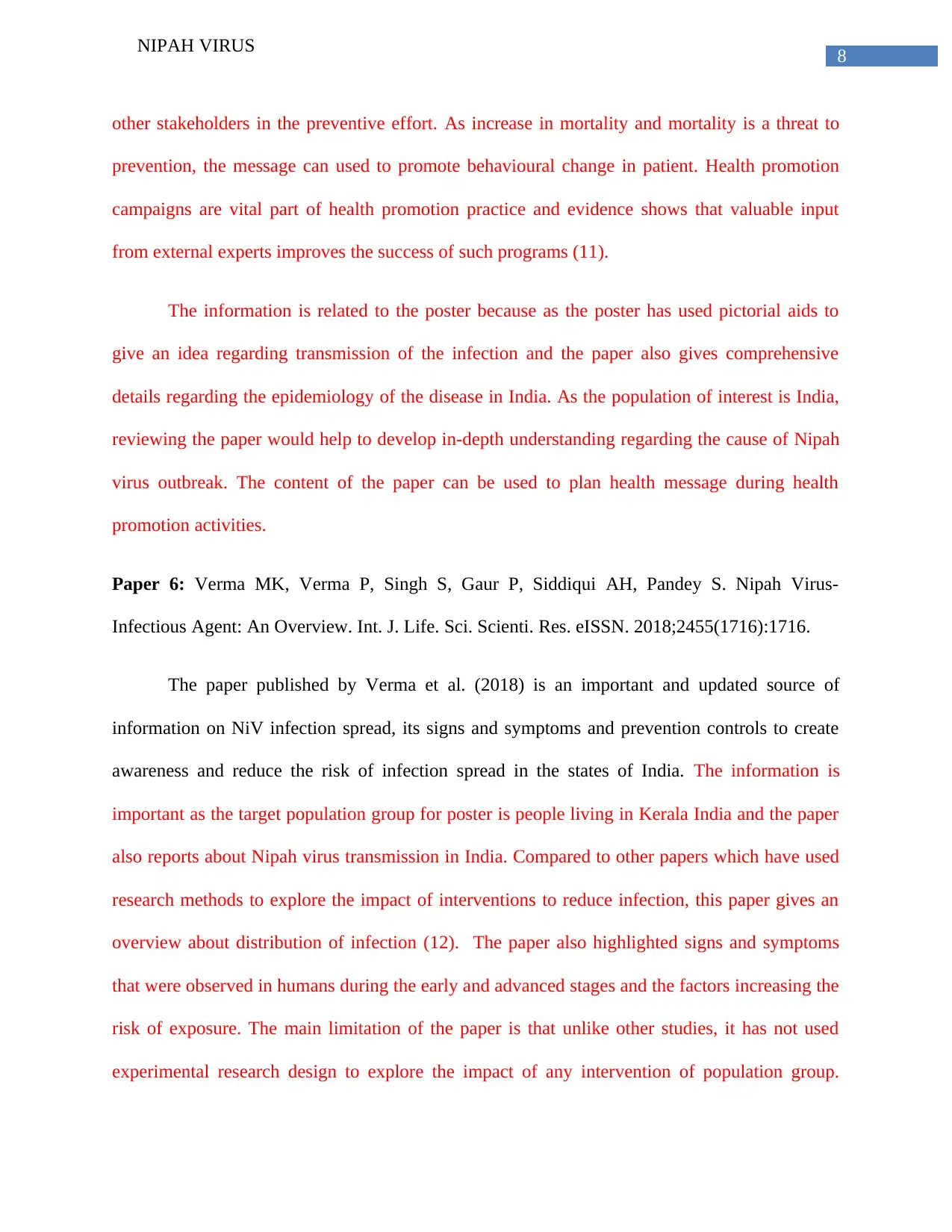
8
NIPAH VIRUS
other stakeholders in the preventive effort. As increase in mortality and mortality is a threat to
prevention, the message can used to promote behavioural change in patient. Health promotion
campaigns are vital part of health promotion practice and evidence shows that valuable input
from external experts improves the success of such programs (11).
The information is related to the poster because as the poster has used pictorial aids to
give an idea regarding transmission of the infection and the paper also gives comprehensive
details regarding the epidemiology of the disease in India. As the population of interest is India,
reviewing the paper would help to develop in-depth understanding regarding the cause of Nipah
virus outbreak. The content of the paper can be used to plan health message during health
promotion activities.
Paper 6: Verma MK, Verma P, Singh S, Gaur P, Siddiqui AH, Pandey S. Nipah Virus-
Infectious Agent: An Overview. Int. J. Life. Sci. Scienti. Res. eISSN. 2018;2455(1716):1716.
The paper published by Verma et al. (2018) is an important and updated source of
information on NiV infection spread, its signs and symptoms and prevention controls to create
awareness and reduce the risk of infection spread in the states of India. The information is
important as the target population group for poster is people living in Kerala India and the paper
also reports about Nipah virus transmission in India. Compared to other papers which have used
research methods to explore the impact of interventions to reduce infection, this paper gives an
overview about distribution of infection (12). The paper also highlighted signs and symptoms
that were observed in humans during the early and advanced stages and the factors increasing the
risk of exposure. The main limitation of the paper is that unlike other studies, it has not used
experimental research design to explore the impact of any intervention of population group.
NIPAH VIRUS
other stakeholders in the preventive effort. As increase in mortality and mortality is a threat to
prevention, the message can used to promote behavioural change in patient. Health promotion
campaigns are vital part of health promotion practice and evidence shows that valuable input
from external experts improves the success of such programs (11).
The information is related to the poster because as the poster has used pictorial aids to
give an idea regarding transmission of the infection and the paper also gives comprehensive
details regarding the epidemiology of the disease in India. As the population of interest is India,
reviewing the paper would help to develop in-depth understanding regarding the cause of Nipah
virus outbreak. The content of the paper can be used to plan health message during health
promotion activities.
Paper 6: Verma MK, Verma P, Singh S, Gaur P, Siddiqui AH, Pandey S. Nipah Virus-
Infectious Agent: An Overview. Int. J. Life. Sci. Scienti. Res. eISSN. 2018;2455(1716):1716.
The paper published by Verma et al. (2018) is an important and updated source of
information on NiV infection spread, its signs and symptoms and prevention controls to create
awareness and reduce the risk of infection spread in the states of India. The information is
important as the target population group for poster is people living in Kerala India and the paper
also reports about Nipah virus transmission in India. Compared to other papers which have used
research methods to explore the impact of interventions to reduce infection, this paper gives an
overview about distribution of infection (12). The paper also highlighted signs and symptoms
that were observed in humans during the early and advanced stages and the factors increasing the
risk of exposure. The main limitation of the paper is that unlike other studies, it has not used
experimental research design to explore the impact of any intervention of population group.
⊘ This is a preview!⊘
Do you want full access?
Subscribe today to unlock all pages.

Trusted by 1+ million students worldwide
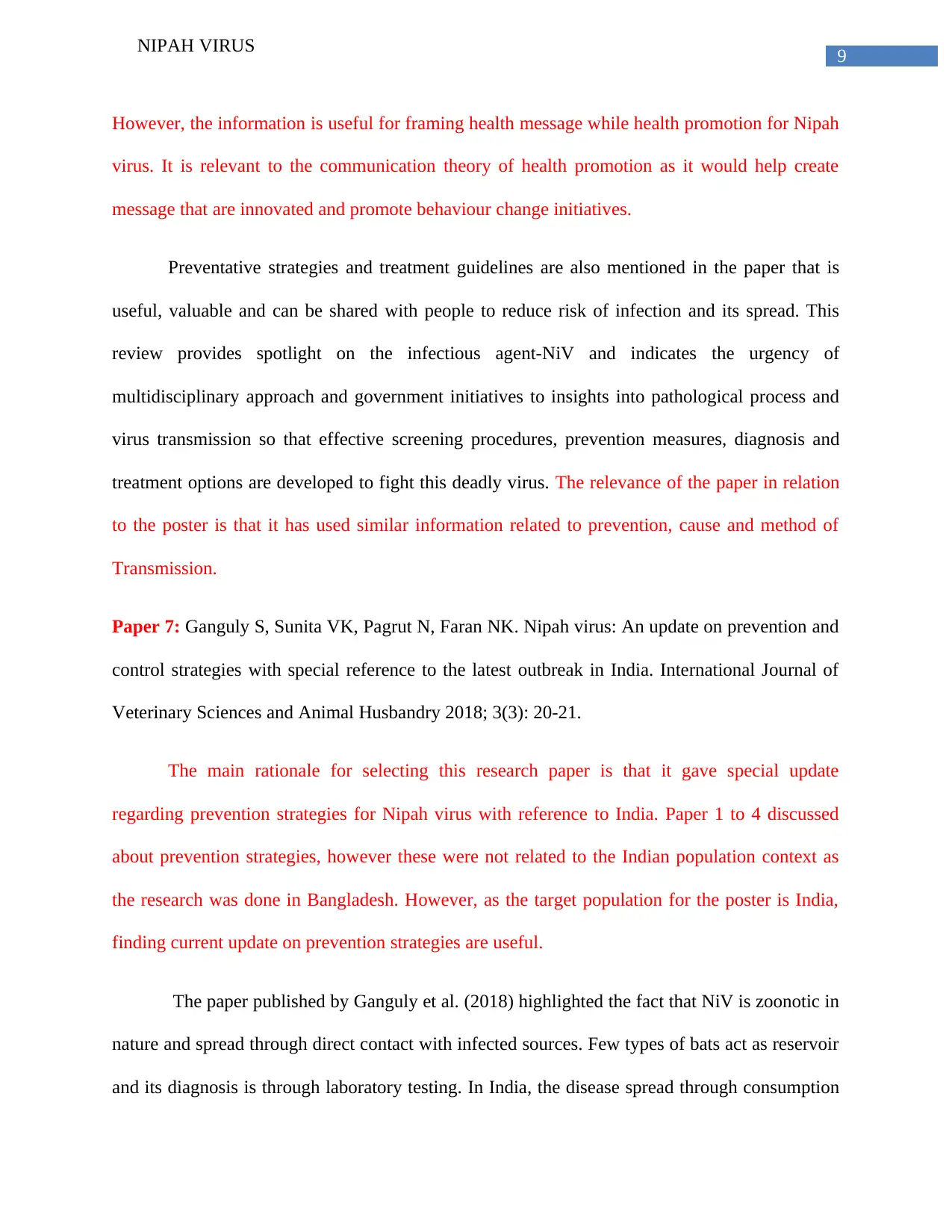
9
NIPAH VIRUS
However, the information is useful for framing health message while health promotion for Nipah
virus. It is relevant to the communication theory of health promotion as it would help create
message that are innovated and promote behaviour change initiatives.
Preventative strategies and treatment guidelines are also mentioned in the paper that is
useful, valuable and can be shared with people to reduce risk of infection and its spread. This
review provides spotlight on the infectious agent-NiV and indicates the urgency of
multidisciplinary approach and government initiatives to insights into pathological process and
virus transmission so that effective screening procedures, prevention measures, diagnosis and
treatment options are developed to fight this deadly virus. The relevance of the paper in relation
to the poster is that it has used similar information related to prevention, cause and method of
Transmission.
Paper 7: Ganguly S, Sunita VK, Pagrut N, Faran NK. Nipah virus: An update on prevention and
control strategies with special reference to the latest outbreak in India. International Journal of
Veterinary Sciences and Animal Husbandry 2018; 3(3): 20-21.
The main rationale for selecting this research paper is that it gave special update
regarding prevention strategies for Nipah virus with reference to India. Paper 1 to 4 discussed
about prevention strategies, however these were not related to the Indian population context as
the research was done in Bangladesh. However, as the target population for the poster is India,
finding current update on prevention strategies are useful.
The paper published by Ganguly et al. (2018) highlighted the fact that NiV is zoonotic in
nature and spread through direct contact with infected sources. Few types of bats act as reservoir
and its diagnosis is through laboratory testing. In India, the disease spread through consumption
NIPAH VIRUS
However, the information is useful for framing health message while health promotion for Nipah
virus. It is relevant to the communication theory of health promotion as it would help create
message that are innovated and promote behaviour change initiatives.
Preventative strategies and treatment guidelines are also mentioned in the paper that is
useful, valuable and can be shared with people to reduce risk of infection and its spread. This
review provides spotlight on the infectious agent-NiV and indicates the urgency of
multidisciplinary approach and government initiatives to insights into pathological process and
virus transmission so that effective screening procedures, prevention measures, diagnosis and
treatment options are developed to fight this deadly virus. The relevance of the paper in relation
to the poster is that it has used similar information related to prevention, cause and method of
Transmission.
Paper 7: Ganguly S, Sunita VK, Pagrut N, Faran NK. Nipah virus: An update on prevention and
control strategies with special reference to the latest outbreak in India. International Journal of
Veterinary Sciences and Animal Husbandry 2018; 3(3): 20-21.
The main rationale for selecting this research paper is that it gave special update
regarding prevention strategies for Nipah virus with reference to India. Paper 1 to 4 discussed
about prevention strategies, however these were not related to the Indian population context as
the research was done in Bangladesh. However, as the target population for the poster is India,
finding current update on prevention strategies are useful.
The paper published by Ganguly et al. (2018) highlighted the fact that NiV is zoonotic in
nature and spread through direct contact with infected sources. Few types of bats act as reservoir
and its diagnosis is through laboratory testing. In India, the disease spread through consumption
Paraphrase This Document
Need a fresh take? Get an instant paraphrase of this document with our AI Paraphraser
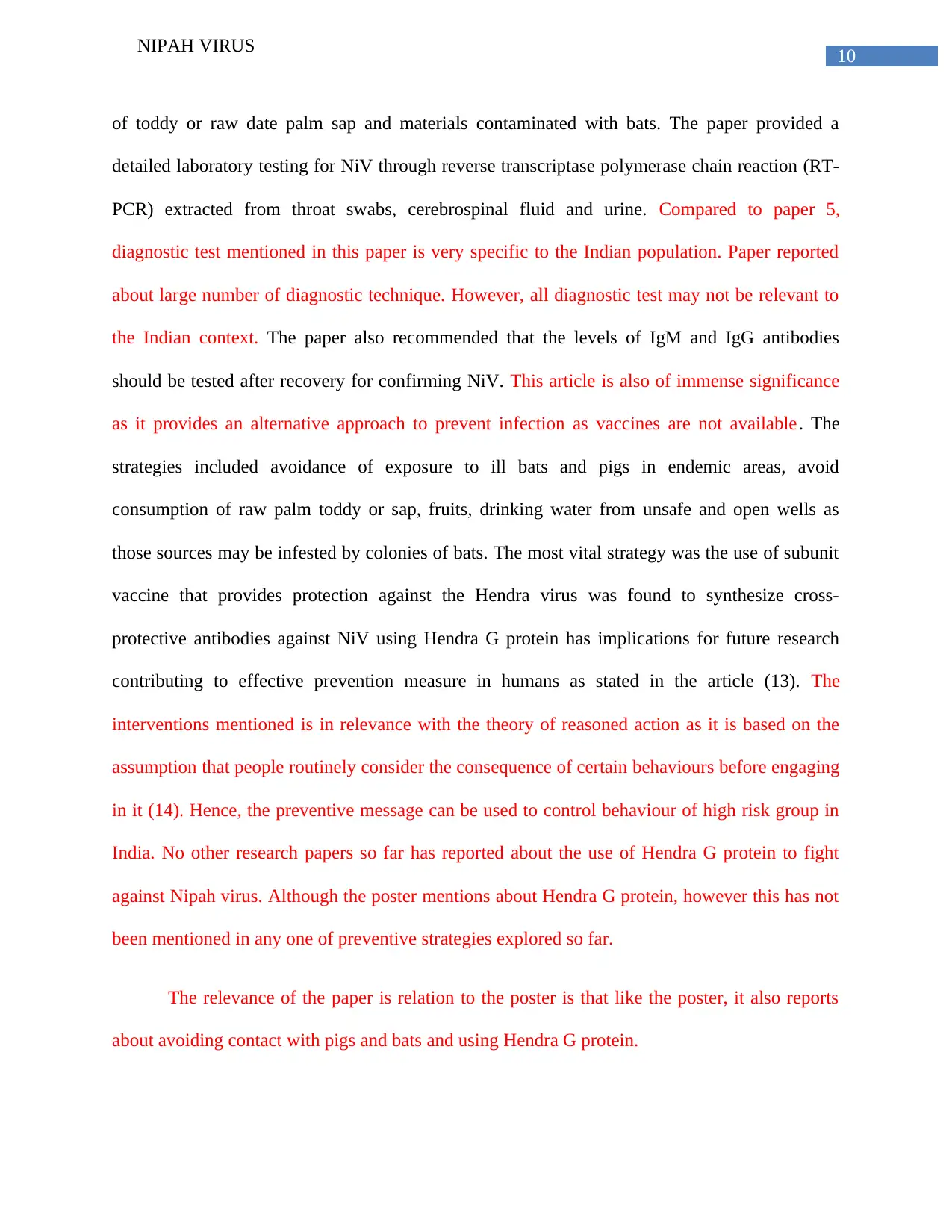
10
NIPAH VIRUS
of toddy or raw date palm sap and materials contaminated with bats. The paper provided a
detailed laboratory testing for NiV through reverse transcriptase polymerase chain reaction (RT-
PCR) extracted from throat swabs, cerebrospinal fluid and urine. Compared to paper 5,
diagnostic test mentioned in this paper is very specific to the Indian population. Paper reported
about large number of diagnostic technique. However, all diagnostic test may not be relevant to
the Indian context. The paper also recommended that the levels of IgM and IgG antibodies
should be tested after recovery for confirming NiV. This article is also of immense significance
as it provides an alternative approach to prevent infection as vaccines are not available. The
strategies included avoidance of exposure to ill bats and pigs in endemic areas, avoid
consumption of raw palm toddy or sap, fruits, drinking water from unsafe and open wells as
those sources may be infested by colonies of bats. The most vital strategy was the use of subunit
vaccine that provides protection against the Hendra virus was found to synthesize cross-
protective antibodies against NiV using Hendra G protein has implications for future research
contributing to effective prevention measure in humans as stated in the article (13). The
interventions mentioned is in relevance with the theory of reasoned action as it is based on the
assumption that people routinely consider the consequence of certain behaviours before engaging
in it (14). Hence, the preventive message can be used to control behaviour of high risk group in
India. No other research papers so far has reported about the use of Hendra G protein to fight
against Nipah virus. Although the poster mentions about Hendra G protein, however this has not
been mentioned in any one of preventive strategies explored so far.
The relevance of the paper is relation to the poster is that like the poster, it also reports
about avoiding contact with pigs and bats and using Hendra G protein.
NIPAH VIRUS
of toddy or raw date palm sap and materials contaminated with bats. The paper provided a
detailed laboratory testing for NiV through reverse transcriptase polymerase chain reaction (RT-
PCR) extracted from throat swabs, cerebrospinal fluid and urine. Compared to paper 5,
diagnostic test mentioned in this paper is very specific to the Indian population. Paper reported
about large number of diagnostic technique. However, all diagnostic test may not be relevant to
the Indian context. The paper also recommended that the levels of IgM and IgG antibodies
should be tested after recovery for confirming NiV. This article is also of immense significance
as it provides an alternative approach to prevent infection as vaccines are not available. The
strategies included avoidance of exposure to ill bats and pigs in endemic areas, avoid
consumption of raw palm toddy or sap, fruits, drinking water from unsafe and open wells as
those sources may be infested by colonies of bats. The most vital strategy was the use of subunit
vaccine that provides protection against the Hendra virus was found to synthesize cross-
protective antibodies against NiV using Hendra G protein has implications for future research
contributing to effective prevention measure in humans as stated in the article (13). The
interventions mentioned is in relevance with the theory of reasoned action as it is based on the
assumption that people routinely consider the consequence of certain behaviours before engaging
in it (14). Hence, the preventive message can be used to control behaviour of high risk group in
India. No other research papers so far has reported about the use of Hendra G protein to fight
against Nipah virus. Although the poster mentions about Hendra G protein, however this has not
been mentioned in any one of preventive strategies explored so far.
The relevance of the paper is relation to the poster is that like the poster, it also reports
about avoiding contact with pigs and bats and using Hendra G protein.
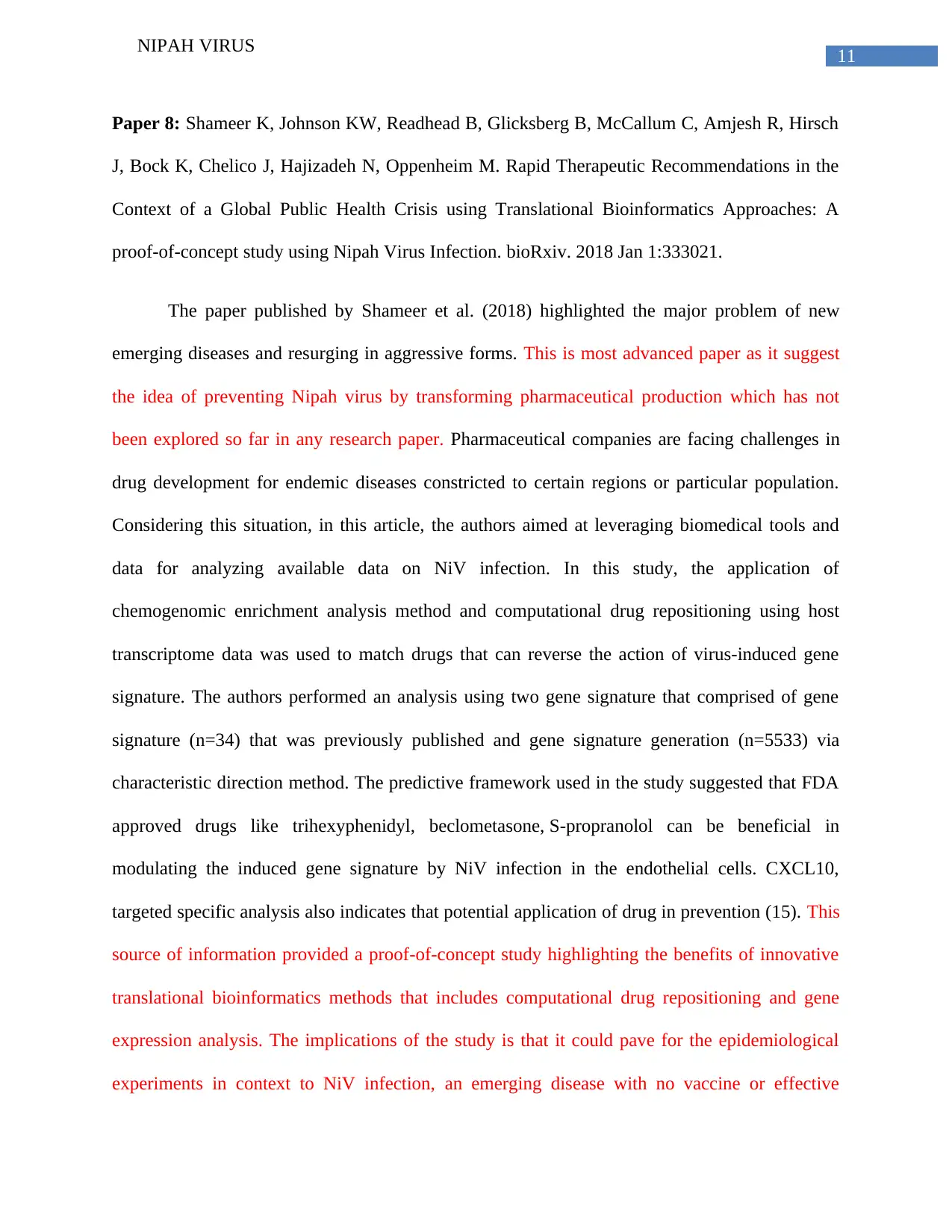
11
NIPAH VIRUS
Paper 8: Shameer K, Johnson KW, Readhead B, Glicksberg B, McCallum C, Amjesh R, Hirsch
J, Bock K, Chelico J, Hajizadeh N, Oppenheim M. Rapid Therapeutic Recommendations in the
Context of a Global Public Health Crisis using Translational Bioinformatics Approaches: A
proof-of-concept study using Nipah Virus Infection. bioRxiv. 2018 Jan 1:333021.
The paper published by Shameer et al. (2018) highlighted the major problem of new
emerging diseases and resurging in aggressive forms. This is most advanced paper as it suggest
the idea of preventing Nipah virus by transforming pharmaceutical production which has not
been explored so far in any research paper. Pharmaceutical companies are facing challenges in
drug development for endemic diseases constricted to certain regions or particular population.
Considering this situation, in this article, the authors aimed at leveraging biomedical tools and
data for analyzing available data on NiV infection. In this study, the application of
chemogenomic enrichment analysis method and computational drug repositioning using host
transcriptome data was used to match drugs that can reverse the action of virus-induced gene
signature. The authors performed an analysis using two gene signature that comprised of gene
signature (n=34) that was previously published and gene signature generation (n=5533) via
characteristic direction method. The predictive framework used in the study suggested that FDA
approved drugs like trihexyphenidyl, beclometasone, S-propranolol can be beneficial in
modulating the induced gene signature by NiV infection in the endothelial cells. CXCL10,
targeted specific analysis also indicates that potential application of drug in prevention (15). This
source of information provided a proof-of-concept study highlighting the benefits of innovative
translational bioinformatics methods that includes computational drug repositioning and gene
expression analysis. The implications of the study is that it could pave for the epidemiological
experiments in context to NiV infection, an emerging disease with no vaccine or effective
NIPAH VIRUS
Paper 8: Shameer K, Johnson KW, Readhead B, Glicksberg B, McCallum C, Amjesh R, Hirsch
J, Bock K, Chelico J, Hajizadeh N, Oppenheim M. Rapid Therapeutic Recommendations in the
Context of a Global Public Health Crisis using Translational Bioinformatics Approaches: A
proof-of-concept study using Nipah Virus Infection. bioRxiv. 2018 Jan 1:333021.
The paper published by Shameer et al. (2018) highlighted the major problem of new
emerging diseases and resurging in aggressive forms. This is most advanced paper as it suggest
the idea of preventing Nipah virus by transforming pharmaceutical production which has not
been explored so far in any research paper. Pharmaceutical companies are facing challenges in
drug development for endemic diseases constricted to certain regions or particular population.
Considering this situation, in this article, the authors aimed at leveraging biomedical tools and
data for analyzing available data on NiV infection. In this study, the application of
chemogenomic enrichment analysis method and computational drug repositioning using host
transcriptome data was used to match drugs that can reverse the action of virus-induced gene
signature. The authors performed an analysis using two gene signature that comprised of gene
signature (n=34) that was previously published and gene signature generation (n=5533) via
characteristic direction method. The predictive framework used in the study suggested that FDA
approved drugs like trihexyphenidyl, beclometasone, S-propranolol can be beneficial in
modulating the induced gene signature by NiV infection in the endothelial cells. CXCL10,
targeted specific analysis also indicates that potential application of drug in prevention (15). This
source of information provided a proof-of-concept study highlighting the benefits of innovative
translational bioinformatics methods that includes computational drug repositioning and gene
expression analysis. The implications of the study is that it could pave for the epidemiological
experiments in context to NiV infection, an emerging disease with no vaccine or effective
⊘ This is a preview!⊘
Do you want full access?
Subscribe today to unlock all pages.

Trusted by 1+ million students worldwide
1 out of 18
Your All-in-One AI-Powered Toolkit for Academic Success.
+13062052269
info@desklib.com
Available 24*7 on WhatsApp / Email
![[object Object]](/_next/static/media/star-bottom.7253800d.svg)
Unlock your academic potential
Copyright © 2020–2025 A2Z Services. All Rights Reserved. Developed and managed by ZUCOL.